| Reviews & Columns |
|
Reviews DVD TV on DVD Blu-ray 4K UHD International DVDs In Theaters Reviews by Studio Video Games Features Collector Series DVDs Easter Egg Database Interviews DVD Talk Radio Feature Articles Columns Anime Talk DVD Savant Horror DVDs The M.O.D. Squad Art House HD Talk Silent DVD
|
DVD Talk Forum |
|
|
| Resources |
|
DVD Price Search Customer Service #'s RCE Info Links |
|
Columns
|
|
|
Devil's Rain, The
Nonetheless, most of The Devil's Rain is very good indeed, similar to and nearly in the same class as both The Devil Rides Out (1968) and The Wicker Man (1973), though not many would agree with that assessment.
The picture was popular when it aired on network primetime television later in the 1970s, and since then on home video, but only Severin's new Blu-ray really does the film justice. The anamorphic widescreen (Todd-AO 35) cinematography by Alex Phillips, Jr. is so critical to conveying the mood Fuest tries to establish, it's a film that really needs to be seen in high-definition on a big screen.
Severin has done a marvelous job with this title, going the extra mile with the supplements as well, all imaginative and informative.
The sketchy plot concerns the Preston family, cursed by 17th century Satanists led by priest Jonathan Corbis (Ernest Borgnine), who was burned at the stake. The Preston family fled to the American Southwest in the 300-plus years since, stealing Corbin's book binding souls of his cult.
The movie opens with an impressively tense sequence, with matriarch Emma Preston (Ida Lupino) and son Mark (William Shatner, in a role obviously written for someone younger than the then-44 year-old actor) anxiously awaiting the return of Emma's husband, Steve (George Sawaya) during a heavy storm. He returns all right, but instantly melts into a pile of waxy ooze at their doorstep. Soon after Emma is kidnapped.
(Spoilers) Mark tracks Corbis to a nearby ghost town, where he challenges Corbis to a battle of their respective faiths, held in a boarded-up, anachronistic New England church, where the followers and their ceremony overwhelm the ill-prepared Christian. Mark's older but similarly impulsive brother, psychic researcher Tom (Tom Skerritt, actually two years younger than Shatner), and his psychically gifted wife, Julie (Joan Prather) next attempt to locate Mark and their parents, aided by Tom's mentor, Dr. Sam Richards (Eddie Albert).
The supplements include an interview with actor Tom Skerritt (MASH) who, recalling his past experiences with improvisation-friendly directors like Robert Altman and his belief that the script was rather goofy, suggested a similarly loose and comical approach to director Fuest, who reportedly agreed to the change. The movie bears this out: in a critical scene between Tom and Dr. Richards, Skerritt and Albert are clearly ad-libbing, using the scripted dialogue merely as a guide. That scene is incongruously amusing, playing rather like Albert's Oliver Douglas character from Green Acres humoring the outrageous claims of farmhand Eb.
In another supplement, brutally frank interview subject Tom Burman, the film's special makeup effects artist, claims Eddie Albert was extremely unhappy about the film, perhaps explaining why he went along with Skerritt's idea to improvise and camp things up.
However, that one scene is the only one like it in the finished film. Their other scenes are as serious-minded as the rest of the picture. On the other hand, second-billed Eddie Albert is barely in the theatrically released version. His character is introduced in a university lecture hall, then reappears suddenly for that strangely campy scene with Skerritt, then comes back suddenly at the end, only to vanish again during the climax. The audience never learns for sure what happens to him.
All this suggests Skerritt filmed scenes with Albert that were deemed too campy by the film's producers, but only some of them were reshot. Possibly Albert was committed to the production for a limited number of days and refused to stay any longer than contractually required. Or maybe the producers didn't want to spend the money or maybe Fuest himself was unavailable, as he apparently suffered a nervous breakdown while The Devil's Rain was being made. In any case the brevity of Albert's Dr. Van Helsing-type part leaves many questions unanswered
The bulk of the film, however, is very good. Most movies, from cheap B-Westerns to weighty courtroom dramas are, while unavoidably stylized, present a kind of impartial movie-real reality. The Devil's Rain, by contrast, is designed as a nightmare, or something resembling one. The effective atonal music by Al De Lory underscores this, as does Phillips's stark photography of the lonely desert landscape.
A feeling of dread hangs over the film, which Fuest sustains despite the shifting tone and contrasting performances. I like both Skerritt and Shatner, but admire Shatner a bit more for his total commitment, whatever he thought of the script. (More Spoilers) After losing his soul to Corbis, becoming another of his eyeless and black-robed followers, Shatner's already pretty good and restrained performance gets even better. The audience really feels Mark Preston's confused agony; it's one of the great, underrated "monster" performances of its type. Ernest Borgnine, likewise, is equally fully committed, genuinely menacing, even overcoming the outrageous but unearthly Baphomet makeup he wears in several scenes. The back jacket describes the cast all "at their most hellishly over-the-top," but no one is hammy, least of all Borgnine and Shatner, who sometimes were in other films.
The movie gained a certain notoriety after John Travolta became a huge star. In The Devil's Rain, his film debut, he has a tiny, virtually unrecognizable part (due to the makeup and costuming), but his signature dimple identifies him in several key scenes, though he has almost no dialogue. The distributor's laughable attempt to cash in on Travolta's newfound fame only damaged the film's reputation further. (It was co-star Joan Prather, incidentally, who encouraged a depressed Travolta to become a Scientologist.)
Other signs point to Fuest working hard to make the picture moody and believable, such as his use of paintings of Hieronymus Bosch under the opening titles, and hiring Church of Satan founder Anton LaVey as a technical advisor. (The latter may have been more a promotional gimmick, but still.)
Video & Audio
The Devil's Rain was filmed in the Panavision/CinemaScope compatible Todd-AO 35, and the 1080p image looks great. The DTS-HD Master Audio 2.0 mono, available in English, Spanish, and French with optional closed-captioning, is impressively robust on this region-free disc.
Extra Features
Supplements abound. First there is an archival audio commentary with director Fuest (who died in 2012), but the rest of the material seems brand-new. There are the aforementioned interviews with actor Tom Skerritt and SFX Artist Tom Berman; an utterly charming interview with script supervisor Ana Maria Quintana, who basically bluffed her way through a job with which she had no prior experience. A delightful storyteller, she went on to an illustrious career that the segment chronicles. There's also an interview with High Priest and High Priestess of the Church of Satan, with filmmaker/collector Daniel Roebuck, and Anton LaVey biographer Blanche Barton. A 1975 interview with William Shatner talks about The Devil's Rain but gives equal time to the proposed Star Trek movie, then in its embryonic state. The film's radio spots accompany on-set Polaroids taken by Quintana, and there are trailers and TV spots, and a poster & still gallery to boot.
Parting Thoughts
Much better than its reputation would suggest, The Devil's Rain is an underrated and even unique horror film, and Severin's fine transfer and superb supplements facilitate the reassessment it deserves. Highly Recommended.
Stuart Galbraith IV is the Kyoto-based film historian largely absent from reviewing these days while he restores a 200-year-old Japanese farmhouse.
|
| Popular Reviews |
| Sponsored Links |
|
|
| Sponsored Links |
|
|
| Release List | Reviews | Shop | Newsletter | Forum | DVD Giveaways | Blu-Ray | Advertise |
|
Copyright 2024 DVDTalk.com All Rights Reserved. Legal Info, Privacy Policy, Terms of Use,
Manage Preferences,
Your Privacy Choices | |||||||














